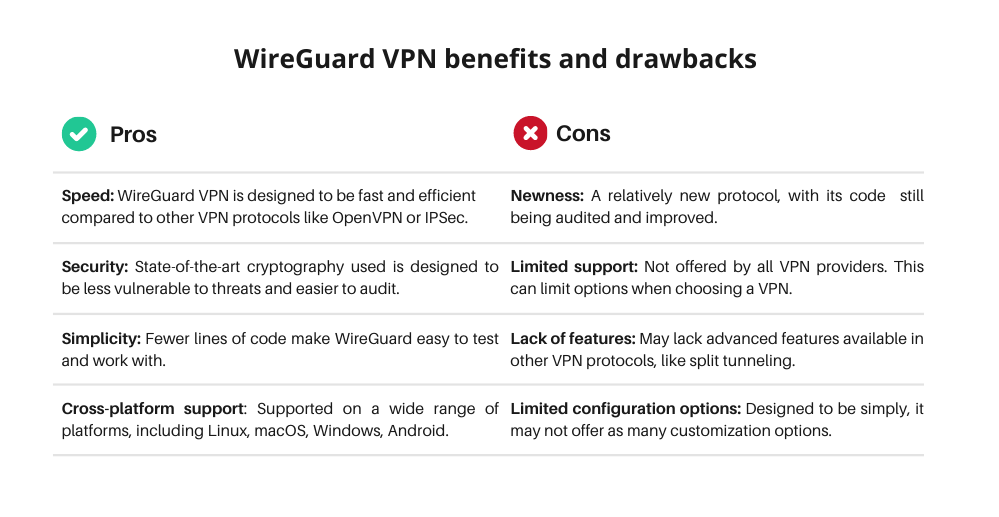Featured
Table of Contents
Use Wireguard Vpn With Strongvpn
It is currently under heavy advancement, however currently it might be considered the most secure, most convenient to use, and easiest VPN option in the market. Wire, Guard aims to be as easy to configure and deploy as SSH. A VPN connection is made merely by exchanging very simple public secrets exactly like exchanging SSH keys and all the rest is transparently managed by Wire, Guard.
There is no requirement to manage connections, be concerned about state, handle daemons, or worry about what's under the hood. Wire, Guard presents a very standard yet effective interface. Wire, Guard has been designed with ease-of-implementation and simplicity in mind. It is meant to be quickly implemented in extremely couple of lines of code, and quickly auditable for security vulnerabilities. what is wireguard protocol and how does it work?.
You then may advance to installation and checking out the quickstart directions on how to use it. If you're interested in the internal inner functions, you may be thinking about the quick summary of the procedure, or go more in depth by checking out the technical whitepaper, which goes into more information on the protocol, cryptography, and principles.

This interface acts as a tunnel interface. Wire, Guard associates tunnel IP addresses with public keys and remote endpoints. When the user interface sends a packet to a peer, it does the following: This packet is meant for 192. 168.30. 8. Which peer is that? Let me look ... Okay, it's for peer ABCDEFGH.
Wireguard — Vpn Server And Client Configuration
If not, drop it. Behind the scenes there is much happening to offer correct personal privacy, credibility, and perfect forward secrecy, utilizing cutting edge cryptography. At the heart of Wire, Guard is a concept called Cryptokey Routing, which works by associating public secrets with a list of tunnel IP addresses that are permitted inside the tunnel (what is wireguard protocol and how does it work?).

Each peer has a public secret. Public keys are brief and easy, and are used by peers to authenticate each other. They can be circulated for usage in setup files by any out-of-band method, similar to how one might send their SSH public key to a good friend for access to a shell server.
0/0 In the server setup, each peer (a customer) will be able to send packets to the network user interface with a source IP matching his matching list of permitted IPs. When a package is gotten by the server from peer g, N65Bk, IK ..., after being decrypted and confirmed, if its source IP is 10.
230, then it's permitted onto the user interface; otherwise it's dropped. In the server setup, when the network user interface wishes to send out a package to a peer (a client), it takes a look at that packet's location IP and compares it to each peer's list of permitted IPs to see which peer to send it to - what is wireguard protocol and how does it work?.
Wireguard Protocol ?️ - Free Vpn

10.10. 230, it will secure it utilizing the general public secret of peer g, N65Bk, IK ..., and then send it to that peer's most current Internet endpoint. In the client setup, its single peer (the server) will be able to send out packages to the network interface with any source IP (since 0.
0/0 is a wildcard). When a package is gotten from peer HIgo9x, Nz ..., if it decrypts and authenticates correctly, with any source IP, then it's enabled onto the user interface; otherwise it's dropped. In the client configuration, when the network interface wishes to send out a package to its single peer (the server), it will secure packets for the single peer with any location IP address (since 0.
0/0 is a wildcard). If the network user interface is asked to send a package with any destination IP, it will secure it using the public secret of the single peer HIgo9x, Nz ..., and then send it to the single peer's most recent Web endpoint. To put it simply, when sending packages, the list of permitted IPs behaves as a sort of routing table, and when receiving packages, the list of allowed IPs behaves as a sort of access control list.
Wire, Guard is completely capable of encapsulating one inside the other if required. Due to the fact that all packets sent on the Wire, Guard interface are encrypted and verified, and because there is such a tight coupling between the identity of a peer and the enabled IP address of a peer, system administrators do not need complicated firewall program extensions, such as in the case of IPsec, however rather they can simply match on "is it from this IP?
Open-source Vpn Protocols Compared: Why Wireguard Is ...

The client setup contains a preliminary endpoint of its single peer (the server), so that it knows where to send out encrypted information before it has gotten encrypted data. The server configuration does not have any initial endpoints of its peers (the customers). This is because the server finds the endpoint of its peers by examining from where properly confirmed information originates.
We also talk about development tasks there and prepare the future of the task.

Do not send non-security-related issues to this e-mail alias. Do not send out security-related concerns to different e-mail addresses. The kernel components are launched under the GPLv2, as is the Linux kernel itself. Other tasks are licensed under MIT, BSD, Apache 2. 0, or GPL, depending upon context.
Wire, Guard is much faster than Open, VPN. It takes in 15% less information, manages network modifications better, and seems secure. However, Open, VPN has been attempted and tested, is more privacy-friendly, and is supported by a bigger variety of VPNs.
Best Vpns With Wireguard In 2023 With Super Fast Speeds
We may get settlement from the services and products discussed in this story, but the opinions are the author's own. Settlement may impact where deals appear. We have actually not consisted of all readily available products or deals. Learn more about how we earn money and our editorial policies. Today, virtual personal networks (VPNs) have taken off, acquiring appeal with those looking for additional security, privacy, and flexibility.
In this article Wire, Guard is a brand-new, open-source VPN protocol created with cutting edge cryptography, which is the practice of coding delicate details so just the intended receivers can analyze its meaning. It provides quicker, easier-to-use, and more safe paths for user devices to get in touch with VPN servers worldwide. Designer Jason A.
Dealing With Wire, Guard could not be easier. Users begin by finding the Wire, Guard application in an online shop, then follow easy download and setup steps. The Wire, Guard app is readily available for desktop and mobile devices for included benefit. Wire, Guard keeps it simple by running with fewer than 4,000 lines of code compared to older VPN protocols that generally utilize thousands more.
Latest Posts
Best Vpns For Business Travelers To Stay Digitally Fit (2023)
The Best Mobile Vpns Of 2023
Best Mobile Vpn 2023